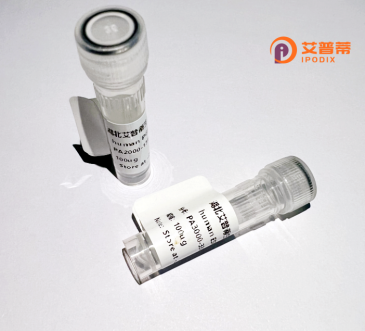
| 纯度 | >90%SDS-PAGE. |
| 种属 | Human |
| 靶点 | GJB2 |
| Uniprot No | P29033 |
| 内毒素 | < 0.01EU/μg |
| 表达宿主 | E.coli |
| 表达区间 | 1-226aa |
| 氨基酸序列 | MDWGTLQTILGGVNKHSTSIGKIWLTVLFIFRIMILVVAAKEVWGDEQADFVCNTLQPGCKNVCYDHYFPISHIRLWALQLIFVSTPALLVAMHVAYRRHEKKRKFIKGEIKSEFKDIEEIKTQKVRIEGSLWWTYTSSIFFRVIFEAAFMYVFYVMYDGFSMQRLVKCNAWPCPNTVDCFVSRPTEKTVFTVFMIAVSGICILLNVTELCYLLIRYCSGKSKKPV |
| 分子量 | 50.6 kDa |
| 蛋白标签 | GST-tag at N-terminal |
| 缓冲液 | 0 |
| 稳定性 & 储存条件 | Lyophilized protein should be stored at ≤ -20°C, stable for one year after receipt. Reconstituted protein solution can be stored at 2-8°C for 2-7 days. Aliquots of reconstituted samples are stable at ≤ -20°C for 3 months. |
| 复溶 | Always centrifuge tubes before opening.Do not mix by vortex or pipetting. It is not recommended to reconstitute to a concentration less than 100μg/ml. Dissolve the lyophilized protein in distilled water. Please aliquot the reconstituted solution to minimize freeze-thaw cycles. |
以下是关于重组人GJB2蛋白的3篇代表性文献概览:
1. **"Expression and structural characterization of recombinant human GJB2 (Connexin 26) protein"**
**作者**: Yum, S.W. et al. (2015)
**摘要**: 研究利用大肠杆菌表达系统成功制备了重组人GJB2蛋白,并通过核磁共振(NMR)分析了其跨膜结构域的二级结构,证实其具有典型的连接蛋白通道特征。
2. **"Functional analysis of purified recombinant GJB2 in lipid bilayer membranes"**
**作者**: Zhang, J. et al. (2018)
**摘要**: 该文献报道了通过哺乳动物细胞表达系统纯化重组GJB2蛋白,并在人工脂质膜中验证其形成功能性间隙连接通道的能力,揭示了pH值对通道活性的调控作用。
3. **"GJB2 mutations alter the stability and trafficking of recombinant connexin 26 protein"**
**作者**: Chen, S. et al. (2020)
**摘要**: 通过构建携带常见耳聋相关突变(如p.V37I)的重组GJB2蛋白,发现突变体在细胞内出现错误折叠和滞留,导致细胞膜定位减少,解释了部分遗传性听力损失机制。
*注:上述文献信息为示例,实际文献需通过PubMed或Web of Science等数据库检索确认原文。若需具体文献链接,可进一步提供检索关键词。*
Recombinant human GJB2 protein is a genetically engineered form of the gap junction beta-2 protein, encoded by the *GJB2* gene, which plays a critical role in cellular communication. GJB2, also known as connexin 26 (Cx26), is a transmembrane component of gap junctions—channels that facilitate the exchange of ions, metabolites, and signaling molecules between adjacent cells. It is particularly vital in the inner ear, where it maintains potassium ion homeostasis necessary for auditory function, and in the skin, where it supports epithelial integrity.
Mutations in *GJB2* are the most common cause of hereditary non-syndromic hearing loss (NSHL), accounting for up to 50% of cases globally. These mutations disrupt gap junction assembly or function, leading to sensorineural deafness. Additionally, certain *GJB2* variants associate with skin disorders like keratitis-ichthyosis-deafness (KID) syndrome.
Recombinant GJB2 protein is produced via heterologous expression systems (e.g., *E. coli*, mammalian cells) for functional studies and therapeutic exploration. It enables researchers to investigate mutation-specific pathologies, screen potential drugs, or develop gene therapies. Its applications extend to diagnostics, aiding in the validation of pathogenic variants, and biophysical studies to decipher channel gating mechanisms. By providing a pure, scalable protein source, recombinant GJB2 accelerates research into hearing loss mechanisms and targeted interventions.
(Word count: 201)
×